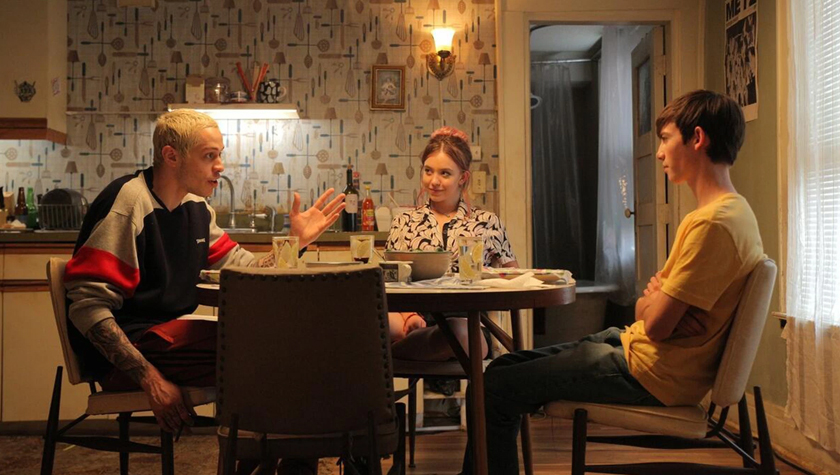What Does "Breaking the Fourth Wall" Mean?
July 11, 2023
What is "breaking the fourth wall?" You may not know what it means or where the phrase originated — but you've definitely seen plenty of examples of it in movies and TV shows.
It's a time-honored storytelling method for either surprising the audience or pulling them deeper into the narrative. And it has enjoyed some surprising recent popularity.
Read More: How breaking the fourth wall in ‘The Good House’ brings out character
Three Walls and Some Imagination
When you watch a play, the set — whatever it's supposed to be: a house, a church, a barn…a junkyard, a flying car, a giant skull (all actual sets) — is typically constructed with only three walls. What would have been the fourth is left open so that the audience can see what's happening on stage.
Everyone in the show, and you as the audience member, are essentially pretending that there's a fourth wall there, even though there isn't. You're going along with the conceit that the characters aren't aware they're characters in a play, aren't aware there is no fourth wall, and aren't aware there is a theater full of people sitting there watching them.
Except, sometimes, the script will call for a character or characters to acknowledge the audience, even speak directly to them. Essentially, they're "breaking the fourth wall."
Sometimes, this is just through one line, traditionally referred to as an "aside." It's a quick wink-wink that only breaks the narrative for a moment.
But it's a moment, line, scene, etc. that makes the audience a more active part of the story, instead of just a passive observer.
Sometimes, it's an entire character, such as the Stage Manager in the Pulitzer Prize-winning play Our Town, who speaks to and interacts with the audience throughout the story, while the other characters remain totally unaware of it.

Similarly, the lead character of Fleabag directly addresses the audience throughout the show, displaying a cheeky honesty with the viewer that she shares with no one else (until the Hot Priest notices it). The fact that Fleabag is breaking the fourth wall becomes not only an integral part of the show, it's an essential element in how the series ends.
Fourth wall breaking is a powerful storytelling tool but one that should be used judiciously and with skill. I'm not going to call out bad examples but they're out there. When breaking the fourth wall doesn't work, it can leave an audience seriously squirming and checking the time because it distances them from the narrative rather than pulling them further in. Call the viewer's attention to the fact that "this is all made up" carefully.
Glorified Narration
A popular recent use of fourth-wall breaking is when a filmmaker deploys the technique in place of what could have otherwise easily been narration. It's not new. Martin Scorsese's gangster classic Goodfellas is mostly narrated by Ray Liotta as Henry Hill, but in the final scenes, he turns directly to the camera in a courthouse, explains what his legal fate was, as he literally walks out of the scene, and the movie — then looks plainly into the camera with a wry smile during the final shot of the character hiding in the suburbs under the witness protection program.
Read More: The Script Lab: Download Goodfellas
This fourth-wall quasi-narration has become a bit trendy: Scorsese uses it again throughout The Wolf of Wall Street, and filmmaker Adam McKay has used it repeatedly in his recent films such as The Big Short and Vice.
I wonder if the rise of social media and "explainer" videos have normalized the broken fourth wall, and if this style will come to replace voiceover narration; I tend to prefer V.O. with some nice visual counterpoint, but you know…angry screenwriter shakes fist at sky. What I'd hate to see is for it to become so popular that it no longer has the power to surprise or delight the viewer. (Or for it to become a default for expositional scenes, where the protagonist just now literally tells us everything we need to know. Thumbs down.)
The Tricky Case of Mockumentaries
Some consider the mockumentary format to be a good example of fourth-wall breakage, but I beg to differ. Technically, a character is only breaking the fourth wall when they begin speaking directly to the audience. In essence, when this happens, it's not just the imaginary fourth wall that is being broken — it's the entire conceit of the narrative.
A character acknowledges that there's an audience, communicating directly with it (even if subtly, with a look). They're now acknowledging the unreality of all that's happening here. A character is saying, I know, and you know, and I know that you know…that this is a movie, or play, or TV show, and that I am an actor in it, and you are in the audience watching it.
In a mockumentary, the characters do turn to the camera and even speak directly to it — but they aren't actually piercing the invisible veil of the narrative because in that scenario, the camera is part of the story. Whether it's "The Office," or "Modern Family" or "Abbott Elementary," the characters know they're making a documentary, and they're filming scenes for that documentary, which is part of the fictional story. They're not really breaking the fourth wall at all — it's still there.
To illustrate: in the final season of "The Office," we meet the filmmakers that the employees of Dunder-Mifflin have been talking to all this time (one of whom has a crush on Pam, which gets a little icky). In the last few episodes, we see parts of the finished documentary series as it begins to air. The narrative space has never been broken — Michael, Jim, Pam, Dwight and company were never talking to us, the viewers. They were always talking to off-screen documentary filmmakers. Who are totally part of the story. Fourth wall: intact.
Read More: How The Office Was Written
Breaking the Fourth Wall is Funny
There's a reason that the mockumentary form is mistaken as a serial fourth-wall basher, though. It's because by far, breaking the fourth wall is mostly found in comedies. We're pretty familiar with a character turning to the camera and speaking directly into it as a joke.
Humor is built on creating an expectation and then defying it in a startling, twisty way. What's a better twist than having a character suddenly and shockingly subvert all expectations by turning to the audience and talking to it?
My 5 personal favorite comedically broken fourth walls:
- A senior citizen being (comically) assailed by thugs in Blazing Saddles turns to the camera and says, "Have you ever seen such cruelty?" (Mel Brooks likes breaking the fourth wall: the entire climax of the same film does it again by revealing it's all a studio movie set.)
- In the first film where James Bond is played by an actor other than Sean Connery (George Lazenby in On Her Majesty's Secret Service), Bond's paramour runs away from him and gets into a car with another man, speeding off. He looks into the camera and says, "This never happened to the other fellow."
- As a wealthy older man condescendingly (wealthsplains?) what "bacon" is to Reggie (Eddie Murphy) in Trading Places, he turns and stares silently into the camera with a very deadpan "Can you believe this?" look.
- Obviously, all of Ferris Bueller's Day Off, but in an early example of the post-credits scene, Ferris scolds the audience for staying all the way to the end: "You are still here? It's over. Go home…go!"
- And of course, the classic fourth-wall-busting Annie Hall scene where Alvy Singer, standing in a line at the movies and irritated by a pompous professor behind him droning on about media theory, steps out of the queue and directly asks the audience what it would do in this situation — then magically produces media theorist Marshall McLuhan to refute the professor's statements with, "You know nothing of my work."
Regardless of how you do it, think of breaking the fourth wall as a narrative tool in your toolkit, and have fun with it — it can be quite a bit of fun to play around with if your story or character is right for it. Just be cautious about over-relying on it to do your heavy story lifting for you.
Keep writing!
Written by: Karl Williams
Karl Williams is a screenwriting instructor at Scottsdale Community College in Arizona. He has won the Comedy and Sci-Fi Awards at the Austin Film Festival and the Jack Nicholson Prize for Excellence in Screenwriting at UCLA, where he earned his MFA.- Topics:
- Discussing TV & Film




